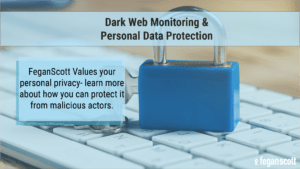 According to Statista, more than 1.35 billion individuals were impacted by data breaches in 2024. As the number and frequency of data breaches continue to rise, knowing how to monitor your data is more important than ever.
According to Statista, more than 1.35 billion individuals were impacted by data breaches in 2024. As the number and frequency of data breaches continue to rise, knowing how to monitor your data is more important than ever.
What is the dark web?
The dark web is a nickname given to a section of the internet that is purposefully built to obscure its existence and the existence of websites within it. The dark web’s main purpose is for users to purchase normally illicit or gray market goods with a level of privacy that the normal internet does not provide to users.
Notably, the dark web allows cybercriminals to sell personal data, or Personally Identifiable Information (“PII”) such as name, email address, Social Security Number (“SSN”) or payment information, or login credentials, which is often obtained through data breaches. PII purchased on the dark web can be used to commit identity fraud.
How can you protect yourself?
While the risk of identity theft may seem daunting, one simple way you can protect yourself is by signing up for dark web monitoring.
Many banks or financial institutions offer free dark web monitoring services. For example:
- Chase Bank provides free dark web monitoring services that automatically notify you if your information is found on the dark web.
- Discover offers free SSN, new inquiry and new account alerts for account holders.
- CreditKarma offers free identity monitoring and alerts.
- AAA offers free dark web surveillance of SSNs and email addresses for AAA members.
Google also offers a free tool to monitor the dark web. If you set up a monitoring profile, Google will alert you if any of your PII is found on the dark web.
What if your information is on the dark web?
If your information is found on the dark web, it is important to closely monitor your accounts and contact your financial institutions if you notice suspicious charges. You can also consider freezing your credit at each of the three major credit bureaus, which is free.
If you are a victim of a data breach or learn that your information is on the dark web, contact us for a free consultation here. To learn more about FeganScott’s fight to protect consumers from data breaches, click here.
